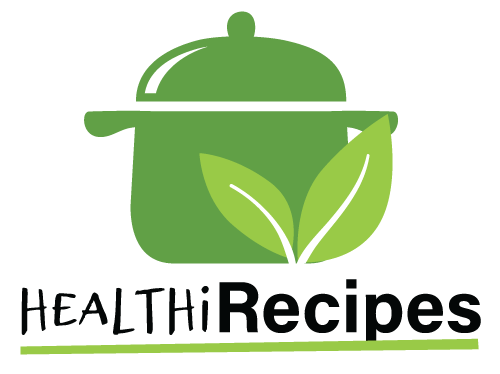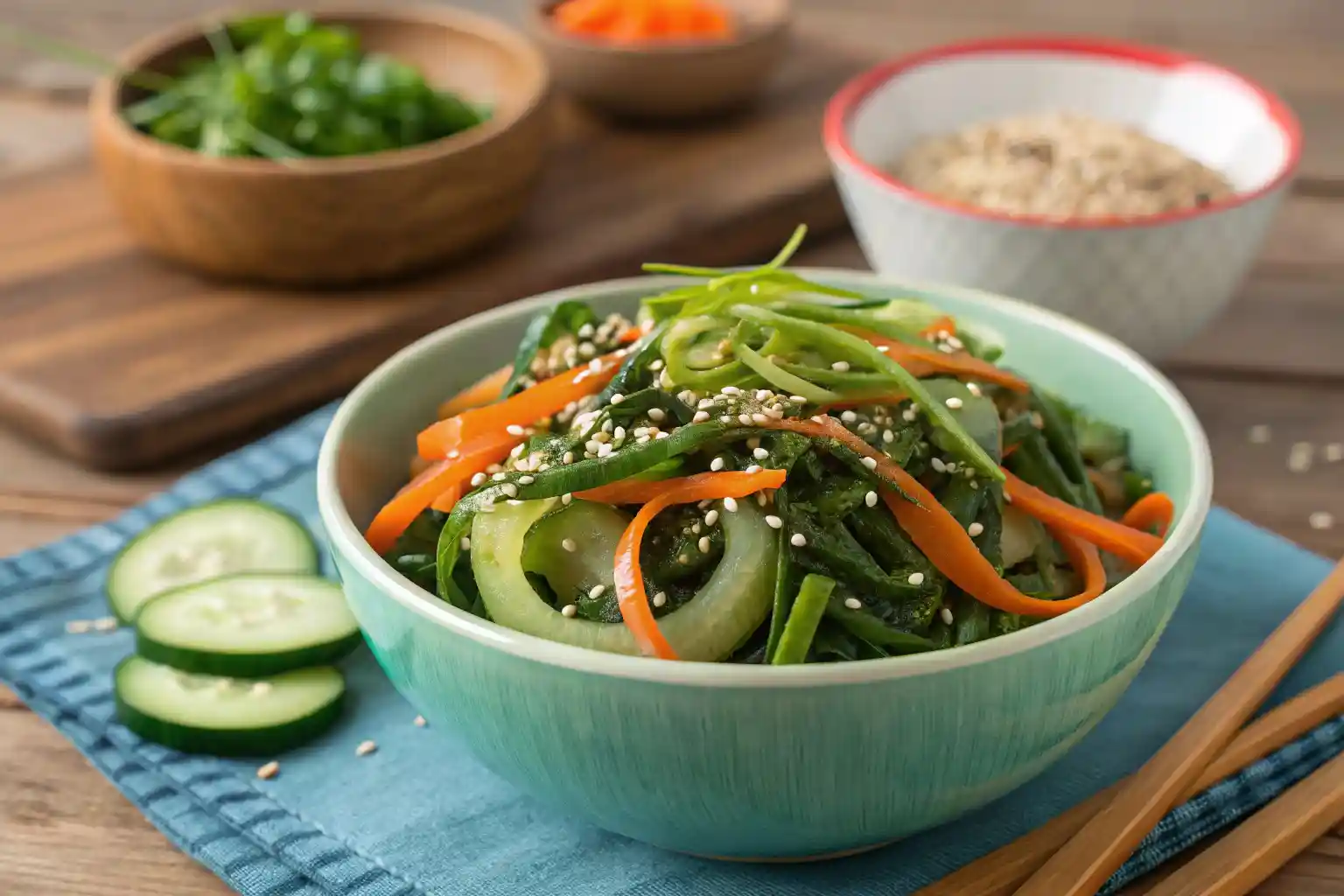Table of contents
1. Is Seaweed Salad Good for You?
Seaweed salad has gained popularity in recent years, often touted as a superfood packed with nutrients. But is it truly a healthy choice? Let’s explore the nutritional benefits and potential drawbacks of incorporating seaweed salad into your diet.
Nutritional Benefits
- Rich in Vitamins and Minerals: Seaweed is a powerhouse of essential nutrients. It contains:
- Vitamin A: Important for vision and immune function.
- Vitamin C: An antioxidant that helps protect cells from damage.
- Vitamin K: Crucial for blood clotting and bone health.
- Iodine: Essential for thyroid function, which regulates metabolism.
- High in Antioxidants: Seaweed is loaded with antioxidants, which help combat oxidative stress in the body. This can reduce the risk of chronic diseases such as heart disease and cancer.
- Dietary Fiber: Seaweed salad is an excellent source of dietary fiber, which aids in digestion and promotes a healthy gut. Fiber can also help you feel full, making it a great addition to weight management plans.
Dietary Fiber Content
- Promotes Digestive Health: The fiber in seaweed can help prevent constipation and promote regular bowel movements.
- Supports Weight Management: High-fiber foods can help you feel satiated, reducing the likelihood of overeating.
Iodine and Thyroid Health
- Natural Source of Iodine: Seaweed is one of the best natural sources of iodine, a mineral that is crucial for thyroid health. The thyroid gland produces hormones that regulate metabolism, energy levels, and overall growth and development.
- Balanced Iodine Intake: While iodine is essential, it’s important to consume it in moderation. Too much iodine can lead to thyroid dysfunction, so it’s best to enjoy seaweed salad as part of a balanced diet.
2. How Often Should You Eat Seaweed Salad?
Incorporating seaweed salad into your diet can be beneficial, but how often should you indulge? Here are some guidelines to consider.
Recommended Frequency
- Moderation is Key: Eating seaweed salad a few times a week can provide health benefits without overdoing it on iodine or sodium.
- Variety in Your Diet: It’s important to balance your diet with a variety of foods. While seaweed salad is nutritious, it should not be the only source of vegetables or nutrients in your meals.
Portion Sizes
- Suggested Serving Sizes: A typical serving of seaweed salad is about 1 cup. This portion can provide a good amount of nutrients without excessive sodium.
- Sodium Considerations: Some seaweed salads can be high in sodium, especially those prepared with soy sauce or other salty dressings. Be mindful of your overall sodium intake, especially if you have high blood pressure or other health concerns.
Personal Health Considerations
- Individual Dietary Needs: Everyone’s nutritional needs are different. If you have specific health conditions, such as thyroid issues or allergies, consult with a healthcare provider to determine the best frequency for you.
- Listen to Your Body: Pay attention to how your body reacts after consuming seaweed salad. If you experience any adverse effects, it may be best to limit your intake.
3. Is Seaweed Better for You Than Spinach?
When comparing seaweed salad to other leafy greens like spinach, it’s essential to consider their nutritional profiles and health benefits.
Nutritional Comparison
- Vitamins and Minerals: Both seaweed and spinach are rich in vitamins and minerals, but they offer different benefits:
- Seaweed: High in iodine, calcium, and certain antioxidants.
- Spinach: Rich in iron, folate, and vitamins A and K.
- Caloric Content: Seaweed salad is generally lower in calories than spinach salad, making it a great option for those looking to manage their weight.
Culinary Uses
- Versatility in Dishes: Seaweed can be used in various dishes, from sushi to soups, while spinach is often used in salads, smoothies, and cooked dishes.
- Flavor Profiles: Seaweed has a unique umami flavor that can enhance the taste of many dishes, while spinach has a milder taste that pairs well with a variety of ingredients.
Dietary Preferences
- Vegan and Vegetarian Considerations: Both seaweed and spinach are excellent choices for plant-based diets. They provide essential nutrients that can be harder to obtain from a vegetarian or vegan diet.
- Cultural Significance: Seaweed is a staple in many Asian cuisines, while spinach is more commonly used in Western dishes.
4. Why Do Japanese Eat So Much Seaweed?

Seaweed is a staple in Japanese cuisine, and its consumption is deeply rooted in cultural practices and beliefs. Understanding why the Japanese eat so much seaweed can provide insights into its health benefits and culinary versatility.
Cultural Significance
- Historical Context: Seaweed has been consumed in Japan for centuries. It is often featured in traditional dishes, reflecting the country’s reliance on marine resources.
- Culinary Traditions: Seaweed is used in various forms, including:
- Nori: Commonly used for sushi and onigiri (rice balls).
- Wakame: Often found in miso soup and salads.
- Kombu: Used to make dashi, a fundamental broth in Japanese cooking.
Health Beliefs
- Perceived Health Benefits: In Japan, seaweed is believed to contribute to longevity and overall health. The rich nutrient profile of seaweed aligns with the Japanese diet, which emphasizes balance and variety.
- Dietary Practices: The Japanese diet is typically low in saturated fats and high in vegetables, fish, and whole grains, making seaweed a perfect complement to their meals.
Modern Trends
- Global Popularity: As the health benefits of seaweed become more recognized, its popularity is spreading beyond Japan. Many people are now incorporating seaweed into their diets worldwide.
- Fusion Cuisine: Chefs are experimenting with seaweed in innovative ways, creating dishes that blend traditional Japanese flavors with modern culinary techniques.
5. What Are the Cons of Eating Seaweed?

While seaweed salad offers numerous health benefits, it’s essential to be aware of potential drawbacks. Here are some considerations to keep in mind.
Potential Risks
- High Sodium Content: Some seaweed varieties can be high in sodium, especially when prepared with salty dressings or sauces. Excessive sodium intake can lead to high blood pressure and other health issues.
- Heavy Metal Accumulation: Seaweed can absorb heavy metals from the ocean, which may pose health risks if consumed in large quantities. It’s crucial to source seaweed from reputable suppliers to minimize this risk.
Allergies and Sensitivities
- Common Allergic Reactions: Some individuals may be allergic to seaweed or experience sensitivities. Symptoms can include digestive discomfort or skin reactions.
- Signs to Watch For: If you’re trying seaweed for the first time, start with a small amount and monitor your body’s response.
Overconsumption Concerns
- Excessive Iodine Intake: While iodine is essential for thyroid health, too much can lead to thyroid dysfunction. It’s important to consume seaweed in moderation, especially if you have thyroid issues.
- Recommendations for Moderation: Aim to enjoy seaweed salad a few times a week rather than daily to maintain a balanced intake of iodine and other nutrients.
6. Is Seaweed Healthier Than Potato Chips?
As snacking habits evolve, many people are looking for healthier alternatives to traditional snacks like potato chips. Let’s compare seaweed salad to potato chips to see which is the better choice.
Nutritional Comparison
- Caloric Content: Seaweed salad is generally lower in calories than potato chips, making it a more weight-friendly option.
- Nutrient Density: Seaweed is rich in vitamins, minerals, and antioxidants, while potato chips are often high in unhealthy fats and low in nutrients.
Health Implications
- Impact on Weight Management: Choosing seaweed salad over potato chips can support weight management goals due to its lower calorie content and higher fiber levels.
- Long-term Health Benefits: Regularly consuming nutrient-dense foods like seaweed can contribute to better overall health, reducing the risk of chronic diseases.
Taste and Texture
- Flavor Profiles: Seaweed has a unique umami flavor that can enhance various dishes, while potato chips are typically salty and crunchy.
- Popularity of Seaweed Snacks: With the rise of health-conscious eating, seaweed snacks are becoming increasingly popular as a tasty and nutritious alternative to traditional chips.
7. Recipe: Seaweed Salad Ingredients and Directions
If you’re convinced of the health benefits of seaweed salad, why not try making it at home? Here’s a simple and delicious recipe to get you started.
Ingredients
- Seaweed:
- 1 cup dried wakame (or your preferred seaweed)
- Vegetables:
- 1/2 cup cucumber, thinly sliced
- 1/2 cup carrots, julienned
- 1/4 cup radishes, thinly sliced
- Dressing:
- 2 tablespoons soy sauce (or tamari for gluten-free)
- 1 tablespoon rice vinegar
- 1 tablespoon sesame oil
- 1 teaspoon sugar (optional)
- 1 teaspoon sesame seeds
- Garnish:
- Chopped green onions (optional)
- Additional sesame seeds for topping
Directions
- Prepare the Seaweed:
- Soak the dried wakame in warm water for about 10-15 minutes until it expands and softens. Drain and squeeze out excess water.
- Prepare the Vegetables:
- While the seaweed is soaking, prepare the cucumber, carrots, and radishes. Place them in a large mixing bowl.
- Make the Dressing:
- In a small bowl, whisk together the soy sauce, rice vinegar, sesame oil, sugar, and sesame seeds until well combined.
- Combine Ingredients:
- Add the soaked seaweed to the bowl with the vegetables. Pour the dressing over the mixture and toss gently to combine.
- Serve:
- Garnish with chopped green onions and additional sesame seeds if desired. Serve immediately or refrigerate for 30 minutes to allow the flavors to meld.
- Enjoy:
- This seaweed salad can be served as a side dish or a light meal. It pairs well with grilled fish or chicken.
8. Conclusion and FAQs
In summary, seaweed salad is a nutritious and versatile dish that can be a healthy addition to your diet. With its rich nutrient profile, including vitamins, minerals, and antioxidants, it offers numerous health benefits. However, moderation is key, as excessive consumption can lead to potential risks such as high sodium intake and iodine overload. By incorporating seaweed salad into a balanced diet, you can enjoy its unique flavors and health advantages.
For those looking to explore more about healthy eating, consider checking out our article on Is Indian Food Healthy? for insights into nutritious options from different cuisines. If you’re interested in meal prep, our guide on Healthy Choice Frozen Meals can provide you with convenient and nutritious meal ideas. Lastly, for a delightful twist on traditional snacks, explore our post on Healthy Tortilla Chips to complement your seaweed salad.
FAQs
- Is seaweed salad good for you?
- Yes, seaweed salad is packed with nutrients, including vitamins, minerals, and antioxidants.
- How often should you eat seaweed salad?
- A few times a week is recommended, but it’s essential to balance it with other foods.
- Is seaweed better for you than spinach?
- Both have unique benefits; seaweed is high in iodine and certain antioxidants, while spinach is rich in iron and folate.
- Why do Japanese eat so much seaweed?
- Seaweed is a staple in Japanese cuisine, valued for its health benefits and cultural significance.
- What are the cons of eating seaweed?
- Potential risks include high sodium content and heavy metal accumulation. Moderation is key.
- Is seaweed healthier than potato chips?
- Yes, seaweed salad is generally lower in calories and higher in nutrients compared to potato chips.

